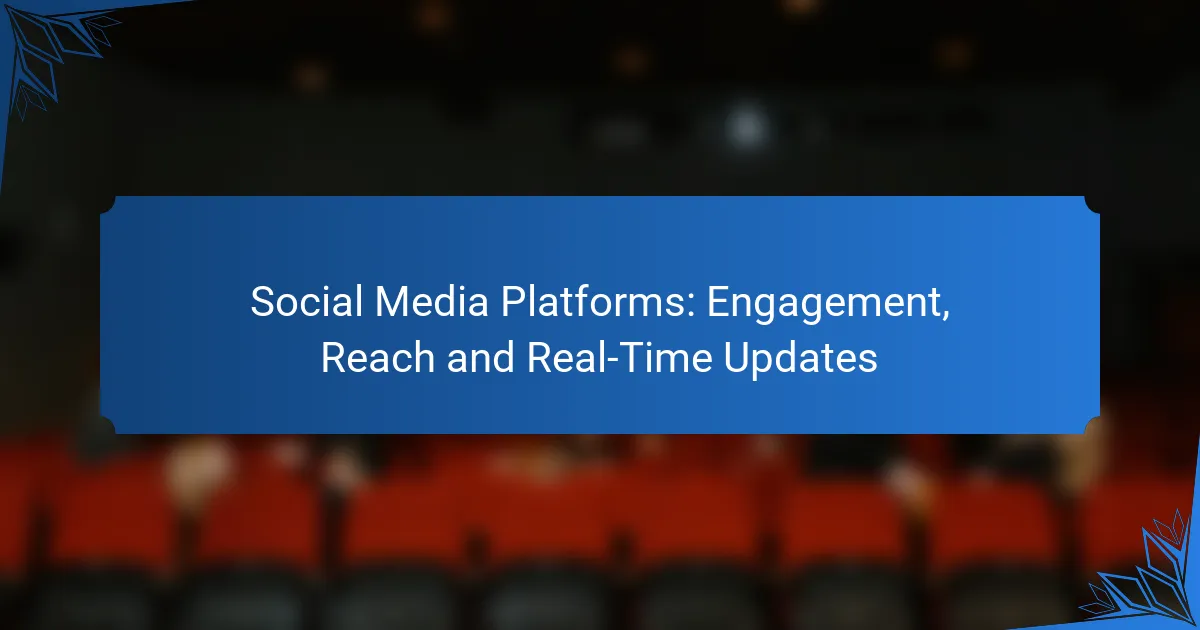Live streaming has become an essential tool for businesses looking to enhance audience engagement and visibility in real time. By utilizing various software and hardware solutions, companies can effectively reach broader audiences while fostering genuine interactions. Incorporating interactive elements during live streams further enriches the viewer experience, making them feel valued and connected to the brand.
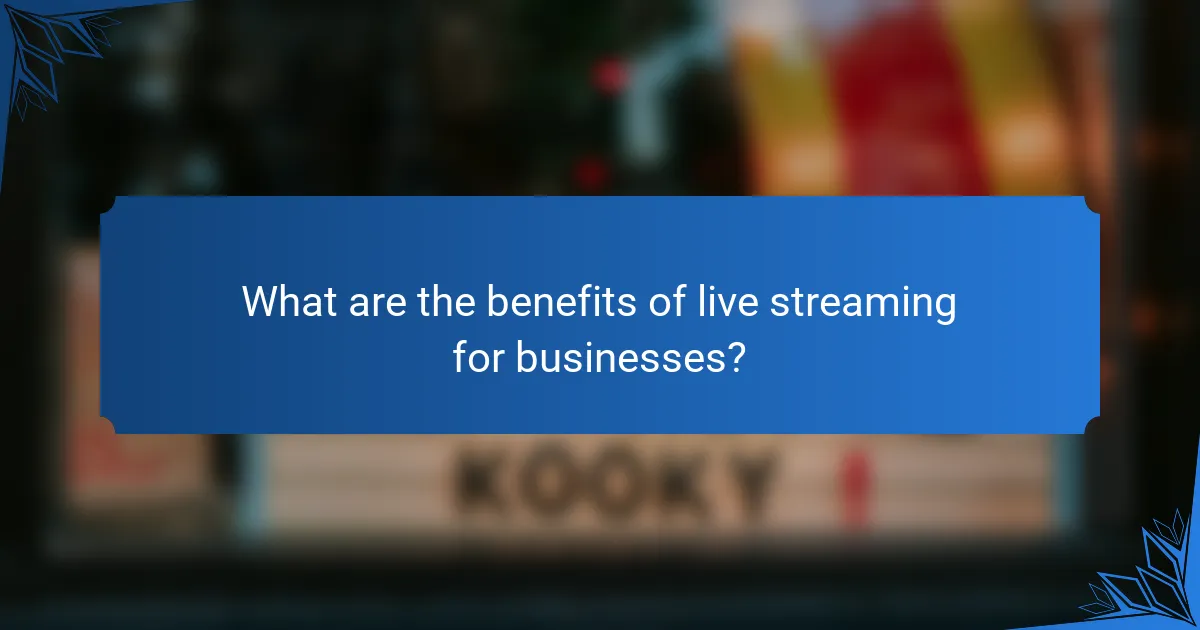
What are the benefits of live streaming for businesses?
Live streaming offers businesses a dynamic way to connect with their audience in real time, enhancing visibility and engagement. By leveraging this technology, companies can reach wider audiences, foster genuine interactions, and promote their brand effectively.
Increased audience reach
Live streaming allows businesses to reach a global audience without geographical limitations. By broadcasting events, product launches, or webinars online, companies can attract viewers from various locations, significantly expanding their market presence.
Utilizing platforms like YouTube Live, Facebook Live, or Twitch can help businesses tap into existing user bases, increasing their visibility. This approach can lead to higher viewer counts and potential customer conversions.
Enhanced audience engagement
Engagement during live streams is typically higher than pre-recorded content, as viewers can participate in real time. Features like live chats, polls, and Q&A sessions foster interaction, making the audience feel more involved and valued.
Encouraging viewers to ask questions or share their thoughts during the stream can create a community atmosphere, enhancing brand loyalty. This interactive element is crucial for building relationships with potential customers.
Cost-effective marketing
Live streaming can be a budget-friendly marketing strategy compared to traditional advertising methods. It often requires minimal investment in equipment and can be executed using smartphones or basic cameras.
Additionally, the potential for organic reach through social media sharing can amplify exposure without incurring extra costs. Businesses can save on venue rentals and travel expenses by hosting events online.
Real-time interaction
One of the standout features of live streaming is the ability for real-time interaction between the brand and its audience. This immediacy allows businesses to address questions, concerns, or feedback instantly, enhancing customer satisfaction.
Real-time interaction can also lead to spontaneous discussions, making the content more relatable and engaging. This responsiveness can differentiate a brand in a competitive market.
Brand authenticity
Live streaming helps convey authenticity, as it showcases the brand’s personality and values in an unscripted format. Viewers appreciate transparency and are more likely to trust brands that share genuine experiences.
By sharing behind-the-scenes content or unfiltered interactions, businesses can create a more relatable image. This authenticity can lead to stronger emotional connections with the audience, fostering loyalty and repeat engagement.
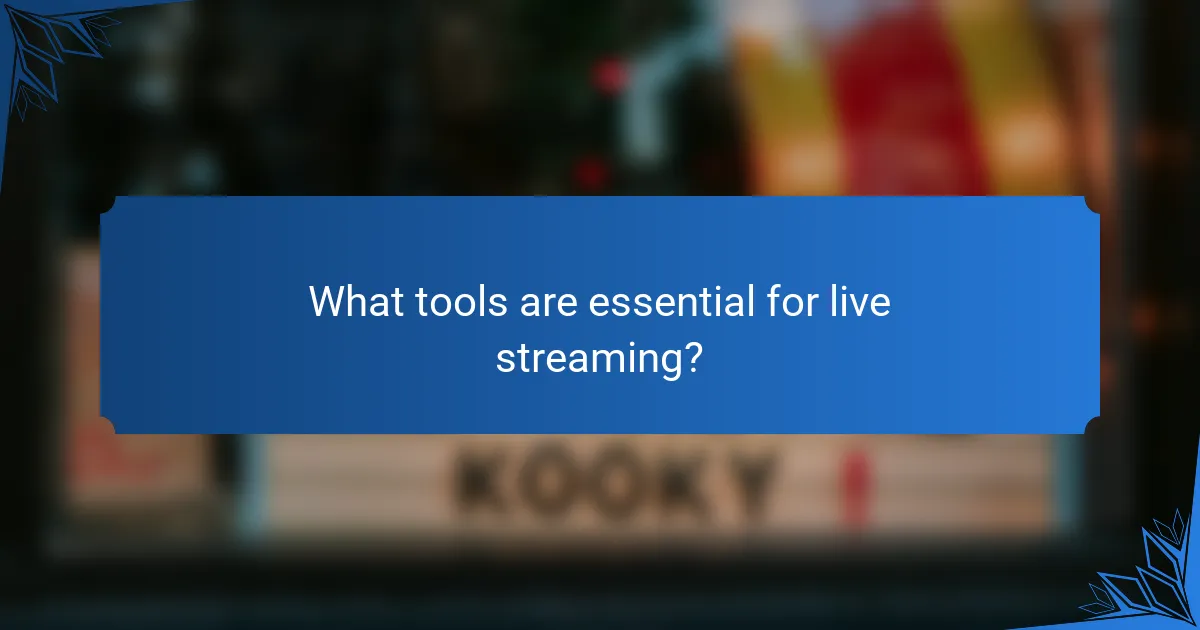
What tools are essential for live streaming?
Essential tools for live streaming include software and hardware that facilitate video capture, encoding, and distribution. Popular choices range from free applications to professional-grade solutions, catering to different needs and budgets.
OBS Studio
OBS Studio is a free and open-source software widely used for live streaming. It allows users to capture video from various sources, including screens and webcams, and stream to platforms like Twitch and YouTube.
Its flexibility is a major advantage, as it supports multiple plugins and customizations. However, beginners may find the interface complex, so exploring tutorials can be beneficial.
Streamlabs
Streamlabs is built on the foundation of OBS but offers additional features tailored for streamers, such as integrated alerts and chat management. It is user-friendly and ideal for those new to live streaming.
Streamlabs also provides monetization options and analytics, making it easier to engage with your audience. However, some advanced features may require a subscription.
Wirecast
Wirecast is a professional live streaming software that supports high-quality production and advanced features like multi-camera switching and instant replay. It is suitable for businesses and organizations looking to create polished broadcasts.
While it offers a robust set of tools, Wirecast comes with a higher price tag, which may not be ideal for casual streamers. Consider your budget and production needs before choosing this option.
Zoom
Zoom is primarily known for video conferencing but can also be used for live streaming events. It allows for easy interaction with participants, making it suitable for webinars and virtual meetings.
While Zoom is accessible and familiar to many users, its streaming capabilities are limited compared to dedicated software. For professional broadcasts, consider integrating Zoom with other tools for enhanced features.
Restream
Restream is a cloud-based service that enables simultaneous streaming to multiple platforms, such as Facebook, YouTube, and LinkedIn. This tool is particularly useful for reaching a broader audience without additional effort.
Restream offers features like chat aggregation and analytics, helping you manage interactions across platforms. However, ensure your internet connection can handle the increased bandwidth demand when streaming to multiple sites.

How can businesses engage their audience during live streams?
Businesses can engage their audience during live streams by incorporating interactive elements that encourage participation and feedback. This creates a dynamic environment where viewers feel connected and valued, enhancing their overall experience.
Interactive polls and Q&A
Interactive polls and Q&A sessions are effective tools for engaging viewers. Polls can gauge audience opinions in real-time, while Q&A segments allow participants to ask questions directly, fostering a sense of community. Consider using platforms that support these features seamlessly.
To maximize engagement, keep polls short and relevant, and encourage questions throughout the stream. Aim for a balance between structured content and spontaneous interaction to maintain viewer interest.
Live chat moderation
Live chat moderation is crucial for maintaining a positive environment during streams. Designate moderators to oversee discussions, ensuring that comments remain respectful and on-topic. This helps prevent spam and negativity, which can deter participation.
Effective moderation includes setting clear guidelines for chat behavior and actively engaging with viewers by acknowledging their comments. This not only keeps the conversation flowing but also makes participants feel heard and appreciated.
Incentives for participation
Offering incentives for participation can significantly boost audience engagement. Consider providing rewards such as discounts, exclusive content, or entry into a giveaway for those who interact during the stream. This encourages viewers to take part actively.
Make sure the incentives are relevant to your audience and align with your brand. Clearly communicate how viewers can earn these rewards to motivate participation throughout the live event.
Exclusive content access
Providing exclusive content access during live streams can create a sense of urgency and excitement. This could include sneak peeks of upcoming products, behind-the-scenes footage, or special guest appearances. Such content makes viewers feel privileged and more likely to engage.
To enhance this strategy, promote the exclusive content in advance and highlight its value during the stream. This approach not only drives engagement but also reinforces brand loyalty among your audience.
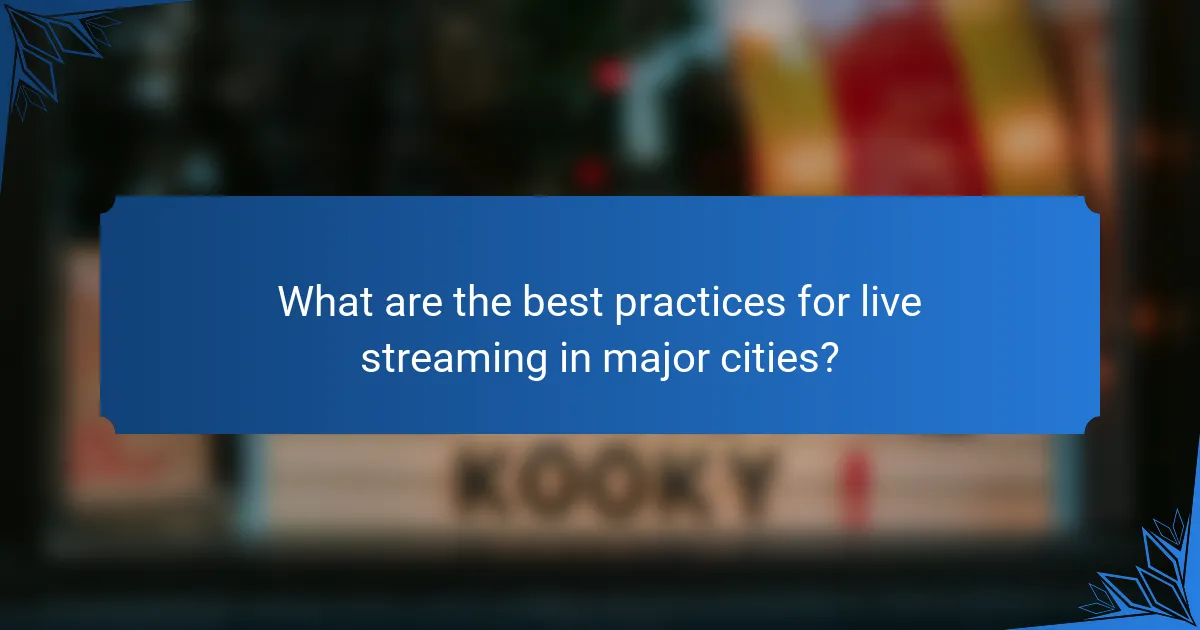
What are the best practices for live streaming in major cities?
To achieve successful live streaming in major cities, focus on high-quality video and audio, maintain a consistent streaming schedule, and implement effective promotion strategies. These practices enhance viewer engagement and ensure a professional presentation.
High-quality video and audio
Investing in high-quality video and audio equipment is crucial for live streaming. Viewers expect clear visuals and crisp sound, which can significantly impact their experience. Aim for a minimum resolution of 720p and consider using external microphones for better audio clarity.
Additionally, test your equipment before going live to avoid technical issues. Ensure your internet connection is stable, ideally with a speed of at least 5 Mbps for smooth streaming. This helps prevent buffering and maintains viewer retention.
Consistent streaming schedule
Establishing a consistent streaming schedule is vital for building an audience. Regularly scheduled streams help viewers know when to tune in, fostering loyalty and anticipation. Consider streaming at the same time each week or month to create a routine.
Use a calendar to plan your content in advance, allowing for better preparation and promotion. Consistency not only enhances viewer engagement but also improves your visibility on streaming platforms, making it easier for new viewers to discover your content.
Effective promotion strategies
Promoting your live streams effectively can significantly increase your audience size. Utilize social media platforms to announce upcoming streams, share behind-the-scenes content, and engage with your audience. Create eye-catching graphics and use relevant hashtags to enhance visibility.
Consider collaborating with influencers or other content creators in your niche to reach a broader audience. Additionally, sending out reminders via email or text can help ensure your audience remembers to join your stream. Engaging with viewers during the stream through Q&A sessions or polls can also boost interaction and retention.
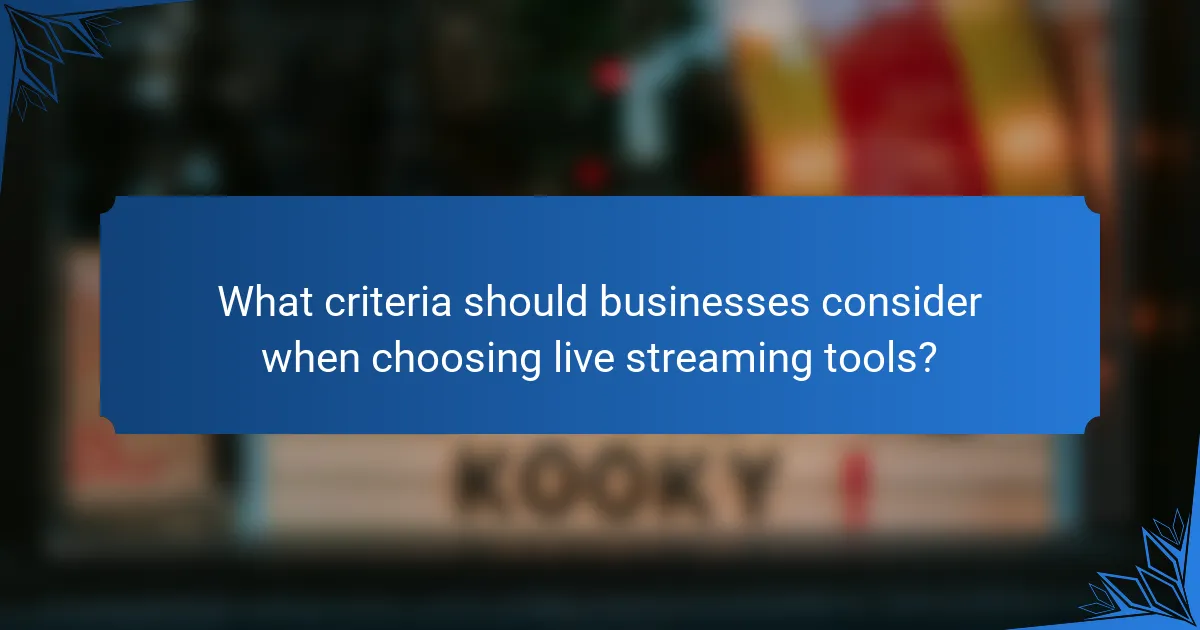
What criteria should businesses consider when choosing live streaming tools?
When selecting live streaming tools, businesses should prioritize factors such as ease of use, compatibility with existing systems, and audience engagement features. Additionally, evaluating the cost and scalability of the tools is crucial for long-term success.
Budget constraints
Budget constraints play a significant role in choosing live streaming tools. Businesses must assess not only the initial costs but also ongoing expenses such as subscription fees, bandwidth charges, and potential equipment upgrades.
For many companies, a budget of a few hundred to a few thousand dollars per month can cover basic streaming needs. However, more advanced features like high-definition streaming or interactive capabilities may require a larger investment. It’s essential to compare different tools to find the best value for the desired features.
To manage costs effectively, consider starting with a free or low-cost tool to test its effectiveness before committing to a more expensive option. Avoid overspending on features that may not be necessary for your audience or business objectives.



